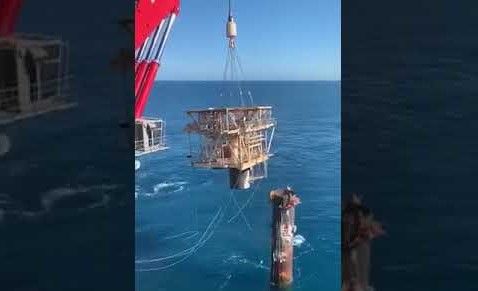Five reasons Australia's green hydrogen dream has foundered
Several big green hydrogen projects have been shelved. An expert explains why Australia’s sky-high ambition for the industry is struggling to reach fruition.
Santos and Chevron, through Varanus and Barrow Islands, have a big part to play in the clean up of 1000 oil and gas wells in WA, with about 300 ready to be plugged now.

Almost 300 oil and gas wells in WA and its coastal waters no longer in production are yet to be made permanently safe, and 700 more wells will require work later, with much of the multi-billion dollar effort to be led by Chevron and Santos.
Last week, Federal Parliament passed legislation to ensure the offshore oil and gas industry was held liable for its clean-up costs and avoid a repeat of the failed Northern Endeavour that could cost taxpayers up to $1 billion without a proposed industry levy.
However, the new stricter approach does not apply to oil and gas infrastructure on land or within three nautical miles (5.6km) of the coast, where states have jurisdiction.
WA's jurisdiction contains 2248 wells, 292 of which are no longer involved in producing oil and gas but are yet to be plugged and abandoned, according to data from the Department of Mines, Industry Regulation and Safety requested by Boiling Cold.

By law, wells must be plugged and abandoned to be made permanently safe for the oil and gas companies to fulfil their legal obligations. In addition, other infrastructure, such as wellheads and pipelines, has to be removed or left in a state acceptable to DMIRS.
Usually, wells are not plugged and abandoned immediately after production stops. A small number could be returned to production later but work on wells is more likely waiting until the operator can decommission a larger number in one campaign to save costs.
If the wait to decommission extends excessively, two problems can result.
Equipment could fall into a state of disrepair that makes the planned work unsafe to perform, as occurred with the riser turret mooring of Woodside's Nganhurra floating production storage and offloading vessel.
With smaller companies, especially those with a single producing asset, the natural decline in production revenue in the years before decommissioning could leave them unable to afford the work.
New Standard Energy was suspended from the ASX in 2019 for not disclosing the decommissioning liability from its drilling in the Kimberley in its accounts and does not have the money to complete work.
Boiling Cold asked Energy Minister Bill Johnston if he was confident that, apart from New Standard Energy, companies with petroleum decommissioning obligations within WA's jurisdiction had the financial means to complete the required work.
A spokesperson for Johnston said DMIRS had the legal power to assess whether a company could afford to meet its legal obligations when it applied for exploration permits and when new entities were transferred onto a title.
DMIRS resource and compliance director Karen Caple said the regulator monitored and adapted its regime to ensure companies met their decommissioning obligations.
Caple said since mid-2017 DMIRS has issued three directions, apart from those to New Standard Energy, to complete the decommissioning of sites and is monitoring the work until it is complete.
However, larger players operate most wells in WA's jurisdiction, particularly Santos offshore and Chevron onshore.

Chevron operates more than half the onshore wells in WA, almost all on Barrow Island, where it has produced oil for 54 years.
Chevron owns 57.1 per cent of the Barrow Island operation, with ExxonMobil owning 14.3 per cent and Santos 28.6 per cent.
Chevron's 2020 Australian accounts recorded a $US576 million impairment for Barrow Island after the assumed end of life for the operation was brought forward.
This impairment, equivalent to $1US billion ($1.37 billion) for 100 per cent of the asset, is not the cost to decommission Barrow Island, just the decrease in the asset's net present value from assuming decommissioning starts earlier.
When the wells are plugged, equipment removed, and land rehabilitated on Barrow Island, the total cost is likely to be much greater than the recent impairment.
The scale of the work on Barrow Island is vast, logistics are challenging, and procedures to protect the environment of the Class A nature reserve while ageing equipment is dismantled will be expensive.

Total production on Barrow Island averaged 4400 barrels a day in 2020, according to Chevron's report. Santos' share amounts to about 0.5 per cent of its production.
For at least the past four years, Santos has reported the value of Barrow Island before decommissioning is allowed for, termed the recoverable amount, as nil.
Santos is also the 100 per cent owner of oil and gas production assets on and around Varanus Island off the Pilbara coast that first produced in 1986. The operation has been successively operated by Occidental, Bond Petroleum, Hadson, Apache, Quadrant and since 2018, Santos.

Santos and its predecessor operators are recorded as responsible for 255 offshore wells in the WA Government's Petroleum Information Management System.
Offshore decommissioning is significantly more complex and costly than onshore work.
In July, two workers dismantling the Sinbad platform near Varanus Island were nearly killed when control of topsides was lost, highlighting that safety is a significant issue on offshore decommissioning where lifts of old equipment of uncertain condition are necessary.

Main image: Varanus Island. Source: Santos.
Correction 9 September 2021: DMIRS has issued three directions beyond those to New Standard Energy. The original story incorrectly said these were to three separate companies.
All the info and a bit of comment on WA energy and climate every Friday